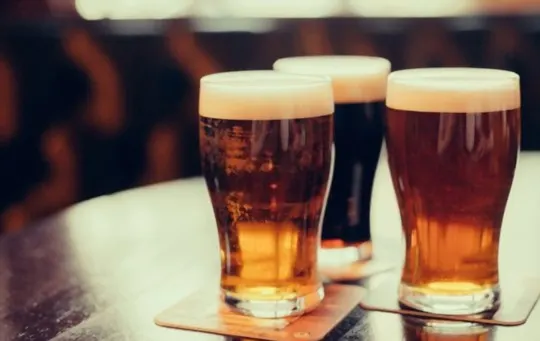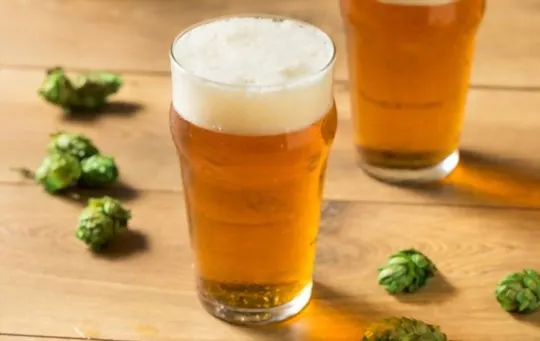Ever find yourself staring at a beer menu, puzzled? You’re not alone. We’ve all been there.
The difference between beer and ale isn’t common knowledge.
Here’s the scoop. Ales are a type of beer. Shocking, we know.
They’re like the cool cousin who shows up at the family BBQ with a guitar.
We love both, honestly. Each has its vibe.
Ales bring the flavor party; they’re bold and assertive.
Beer? It’s the chill one. Crisp, refreshing.
Perfect for those hot summer days or just because.
We’ve had moments, choosing between the two. Trust us; it’s a fun dilemma to have.
What is Beer?

Beer is an old alcoholic beverage.
It’s made with malty grains, hops, yeast and H2O.
Brewing beer requires several stages: mashing, boiling, fermenting, and maturing.
Ales and lagers are the two main types of beer.
Ales are top-fermented brews fermented at warmer temperatures, with yeast that rises in the fermenting process.
They have a fruity or spicy aftertaste, a fuller body, and higher alcohol content than lagers.
Lagers are bottom-fermented beers, fermented at cooler temperatures.
Yeast used in the process sinks.
Lagers have a light taste, body, and lower alcohol content than ales.
Note that not all beers are ales and not all beers are lagers.
Knowing the difference between ales and lagers helps you choose the right beer for your taste.
What is Ale?

Ale is a special beer brewed using a top-fermenting yeast.
It gives a distinct taste, aroma, and color due to the warmer fermentation temperatures.
Ales are often described as having fruity or floral notes and a fuller body than lagers.
Subtypes include pale ale, brown ale, IPA, and stout.
The history of ale has been linked to ancient civilizations.
The Babylonians and Egyptians brewed ‘zythum’, while the Celts used barley malt and water.
In medieval times, ale was everyone’s drink due to its ingredients being available everywhere.
Ales are also great for food pairings.
Their rich flavor profile makes them perfect with meat stews, soups, and roasts.
Darker ales are great with desserts like chocolate or fruit pies.
Overall, ales have been around for centuries and still enchant beer lovers today.
They offer a world of flavors from different parts of the globe.
Differences Between Beer and Ale

Beer and ale – two terms many use interchangeably, without realizing the differences.
Both are made from malted grains and hops.
But, production process, yeast strains, flavor, and alcohol content differ.
Beer is a broad term.
It includes lagers, stouts, and pilsners.
Brewed with bottom-fermenting yeast, at lower temperatures.
Resulting in a clean taste, with fewer fruity or spicy notes.
Ale is a type of beer.
Made with top-fermenting yeast at higher temperatures.
Offering a full-bodied texture, with more noticeable fruity or spicy notes.
And higher alcohol content than most beers.
Carbonation level also differs.
Ales have less fizz as they use natural carbonation from the fermentation process.
Choose wisely when picking your brew.
Whether you like lager, or a bold IPA.
There’s something for everyone.
But remember to drink responsibly.
Ingredients Used
Beer and ale – they may seem like the same thing, but they differ in their ingredients.
Water, malted barley, hops, and yeast are the four main components of both.
Beer is made with bottom-fermenting yeast, while ale uses top-fermenting yeast and an added malt from a grain other than barley – wheat or rye.
This extra malt offers unique flavors to the ale.
Brewing beer or ale takes time and precision.
Every element – ingredient amounts, temperature, timing – must be carefully considered.
Variations during fermentation can create huge changes in taste.
Therefore, brewers often try out their recipes with small batches before brewing larger ones.
Craft breweries put their own flair into their craft beers and ales.
Fruits, juices, spices, smokiness – all these ingredients can be included for a unique flavor.
Whether you’re at a bar or drinking at home – it’s nice to know what’s in your brew to make it a more enjoyable experience.
Fermentation Process
Fermentation is a magical transformation.
It changes simple sugars into alcoholic drinks.
Beer and ale have similar fermentation processes, but there are differences.
Ales ferment at higher temperatures, creating flavorful and strong drinks with higher alcohol.
Beers ferment at colder temperatures and give clean and crisp tastes with less alcohol.
Time-wise, fermentation can last from one week to several months for special ales.
Flavor and Aroma
The flavor of beer and ale is diverse.
It could be light and crisp, or deep and malty.
Ale usually has a more powerful taste with fruity or spicy notes.
Hops give beer its floral or herbal smell, while yeast makes ales more complex.
Finding the best beer for you is all about trial and error.
Here’s to you.
Color and Appearance
Beer & ale have been around for centuries.
They differ in color & looks.
Beer is from pale yellow to rich amber.
Ale has a darker hue, from light copper to dark brown.
Ale’s cloudier due to more yeast.
The foam on beer lasts longer than on ale – making it look better.
Lagers have a clear finish too.
Brewers take pride in the appearance of their beer/ale – it amps up the overall drinking experience & looks of the product.
Similarities Between Beer and Ale
Beer and ale are often confused, but they do share similarities.
Both are alcoholic beverages made from malted grain, hops, yeast, and water.
Combined and fermented, they make a flavorful and refreshing drink.
The major difference between beer and ale is the type of yeast used during fermentation.
Beer uses bottom-fermenting yeast at lower temperatures and ale uses top-fermenting yeast at warmer temperatures.
This affects flavor profile, texture, and alcohol content.
Ales have an interesting history too.
They were popular in England during the Middle Ages.
Royalty and commoners alike enjoyed them.
In fact, many towns had their own signature ales that were brewed for centuries.
Types and Varieties of Beer and Ale

Beer and ale – two popular alcoholic drinks.
But, do you know the difference? Both use malted grains, yeast and water, yet the type of yeast is the main difference.
Ale is made with top-fermenting yeast and warm fermentation; beer with bottom-fermenting yeast, in cooler temperatures and longer maturation.
Ales have a stronger taste and a fruity aroma due to the higher fermentation temperature.
Plus, they are thicker and darker.
Popular kinds of ale: Pale Ale, India Pale Ale (IPA), Stout, Porter, Brown Ale.
Beers have a lighter body and less fruity or spicy tones.
Rather, they often have bitter hop flavors to balance out the sweetness from malted barley or wheat.
Types of beer: Pilsner, Wheat Beer, Lager, Belgian-style Saison.
Modern brewing techniques have blurred the lines between beer and ale.
Take the American-style IPA for example, which combines elements from both styles.
To conclude, what distinguishes beer and ale is mainly the type of yeast used, giving them variant flavor profiles.
Conclusion
Beer and ale are often confused, but they are not the same.
Ales are brewed from grains with top-fermenting yeast and ferment at warmer temperatures.
Lagers use bottom-fermenting yeast and ferment at colder temperatures.
So, ales tend to be darker and fuller-bodied compared to lagers.
Whether you prefer beer or ale is a matter of personal preference.
But it’s clear that they have distinct flavors.
Beer is refreshing and goes well with certain foods.
Ale provides bold flavors to those who enjoy complex and robust tastes.

Leave a comment